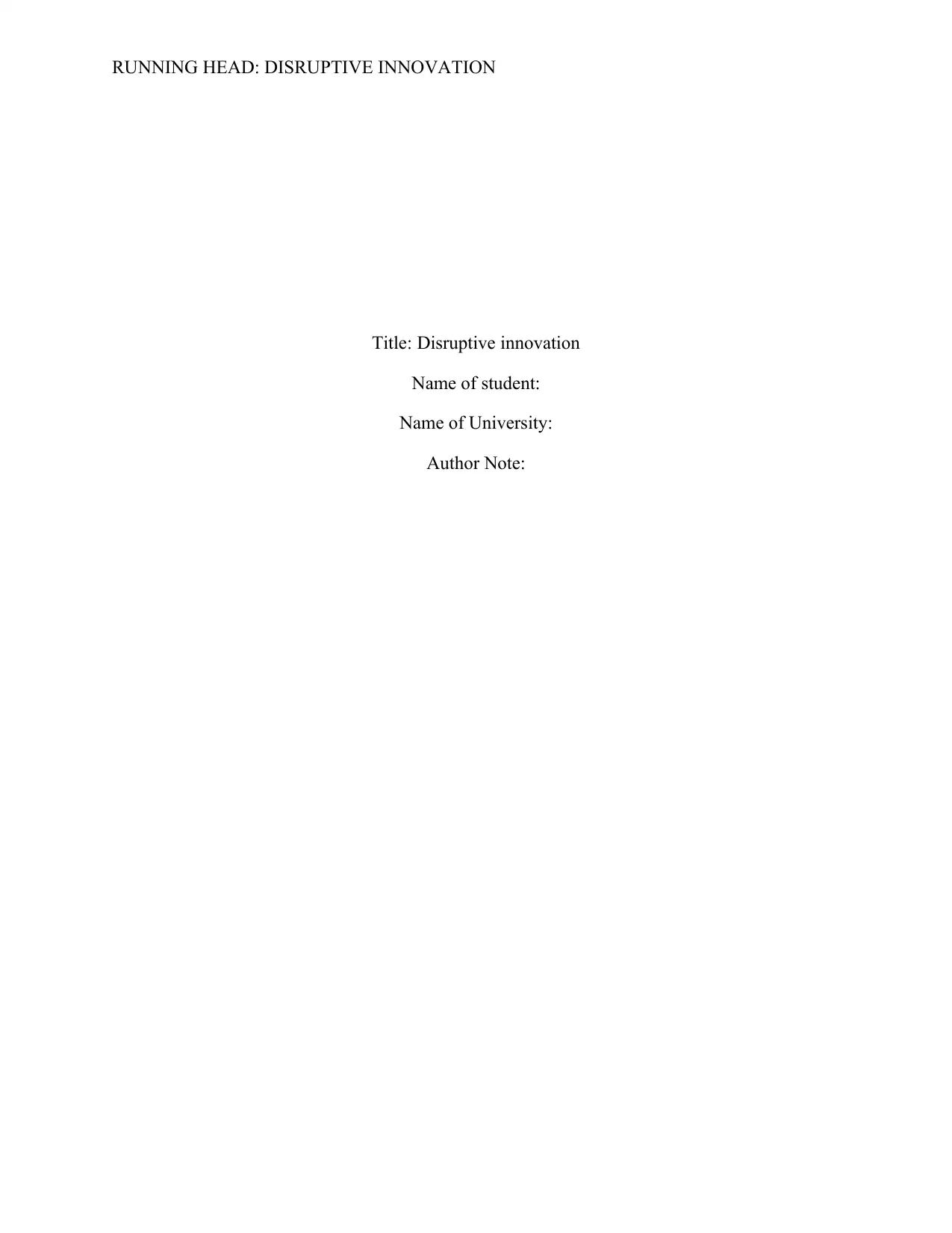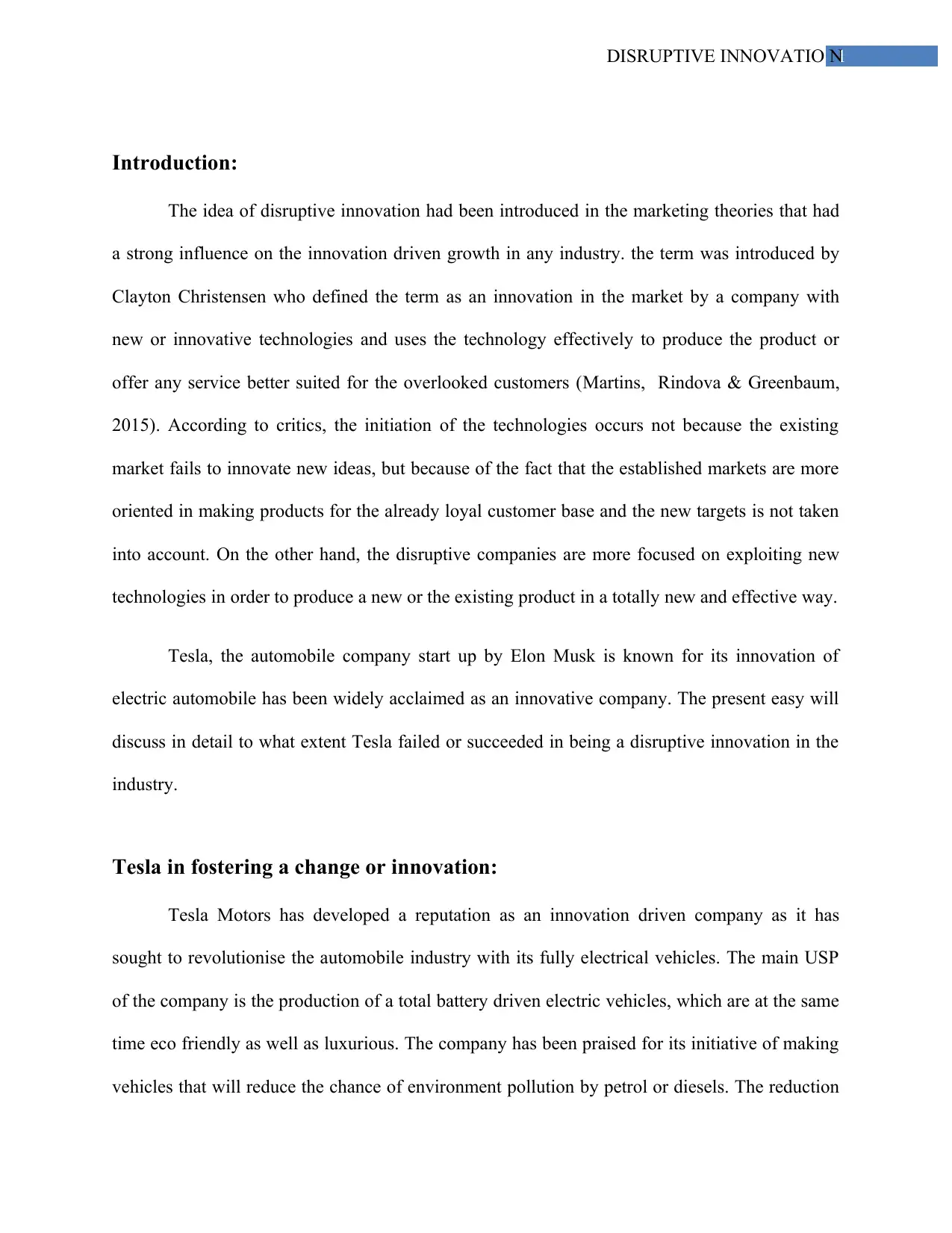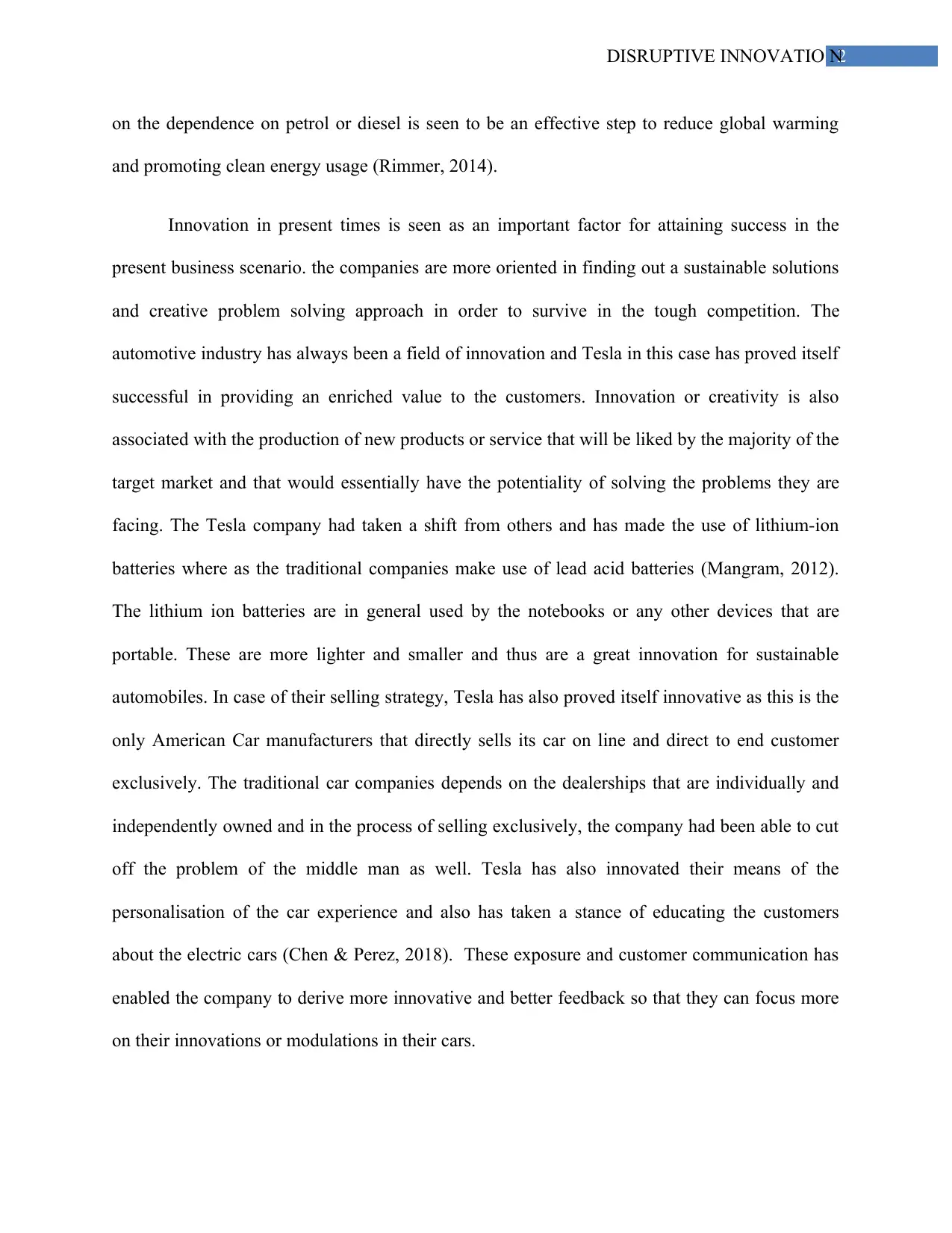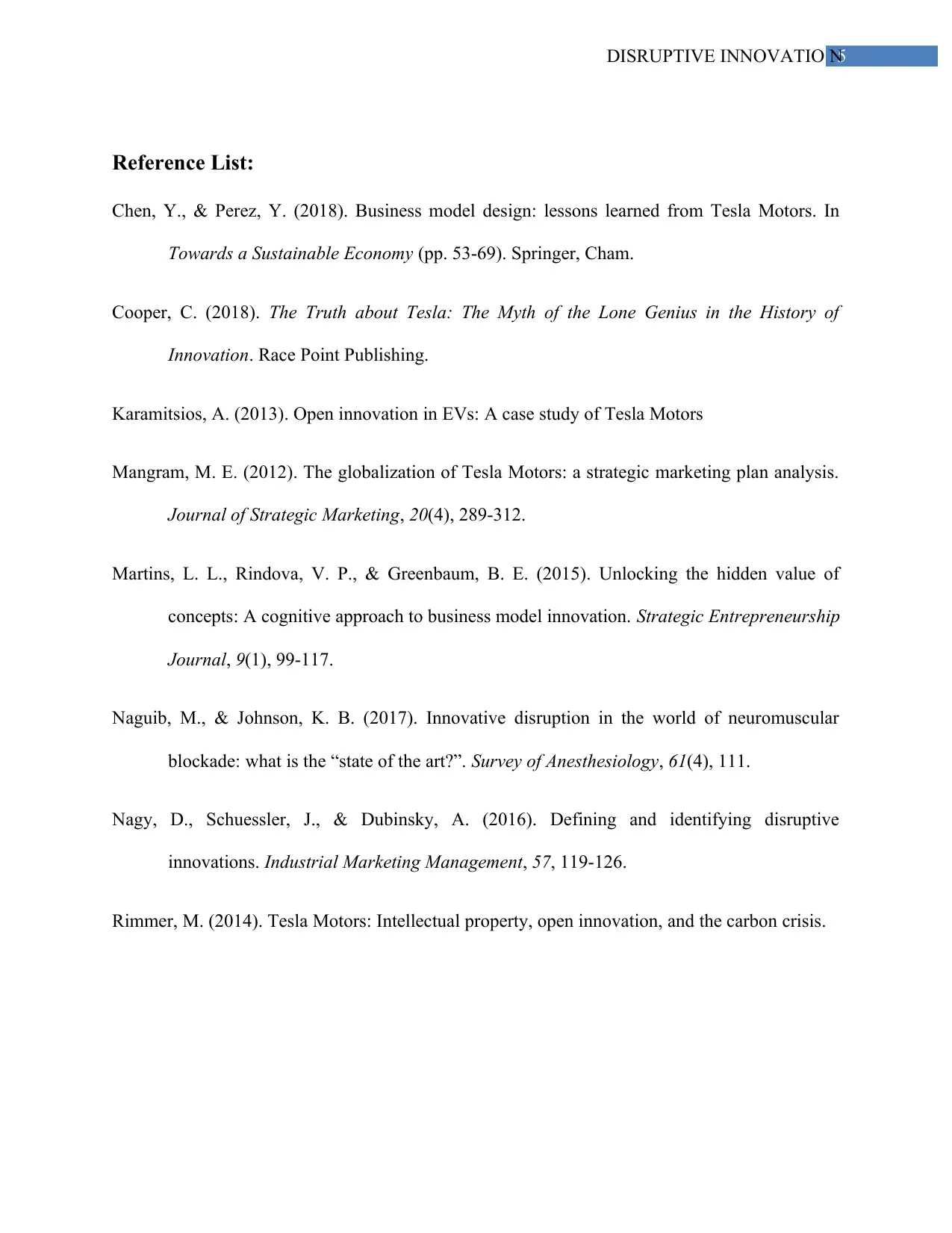University Assignment: Disruptive Innovation Analysis of Tesla Motors
VerifiedAdded on 2022/08/16
|6
|1343
|9
Report
AI Summary
This report delves into the concept of disruptive innovation, using Tesla Motors as a case study to assess its impact on the automotive industry. The analysis begins with an introduction to disruptive innovation, as defined by Christensen, and then examines Tesla's innovations, particularly its electric vehicles, lithium-ion batteries, and direct-to-consumer sales model. The report then critically evaluates whether Tesla truly fits the definition of a disruptive innovator, considering factors such as price point, target market, and competition from established automakers like Mercedes and BMW. It concludes that while Tesla is innovative, its classification as a disruptive innovator is debatable. The report highlights areas where Tesla can improve, such as fully automated manufacturing and integration of artificial intelligence and robotics. The report uses various sources to support its claims.

RUNNING HEAD: DISRUPTIVE INNOVATION
Title: Disruptive innovation
Name of student:
Name of University:
Author Note:
Title: Disruptive innovation
Name of student:
Name of University:
Author Note:
Paraphrase This Document
Need a fresh take? Get an instant paraphrase of this document with our AI Paraphraser

1DISRUPTIVE INNOVATIO N
Introduction:
The idea of disruptive innovation had been introduced in the marketing theories that had
a strong influence on the innovation driven growth in any industry. the term was introduced by
Clayton Christensen who defined the term as an innovation in the market by a company with
new or innovative technologies and uses the technology effectively to produce the product or
offer any service better suited for the overlooked customers (Martins, Rindova & Greenbaum,
2015). According to critics, the initiation of the technologies occurs not because the existing
market fails to innovate new ideas, but because of the fact that the established markets are more
oriented in making products for the already loyal customer base and the new targets is not taken
into account. On the other hand, the disruptive companies are more focused on exploiting new
technologies in order to produce a new or the existing product in a totally new and effective way.
Tesla, the automobile company start up by Elon Musk is known for its innovation of
electric automobile has been widely acclaimed as an innovative company. The present easy will
discuss in detail to what extent Tesla failed or succeeded in being a disruptive innovation in the
industry.
Tesla in fostering a change or innovation:
Tesla Motors has developed a reputation as an innovation driven company as it has
sought to revolutionise the automobile industry with its fully electrical vehicles. The main USP
of the company is the production of a total battery driven electric vehicles, which are at the same
time eco friendly as well as luxurious. The company has been praised for its initiative of making
vehicles that will reduce the chance of environment pollution by petrol or diesels. The reduction
Introduction:
The idea of disruptive innovation had been introduced in the marketing theories that had
a strong influence on the innovation driven growth in any industry. the term was introduced by
Clayton Christensen who defined the term as an innovation in the market by a company with
new or innovative technologies and uses the technology effectively to produce the product or
offer any service better suited for the overlooked customers (Martins, Rindova & Greenbaum,
2015). According to critics, the initiation of the technologies occurs not because the existing
market fails to innovate new ideas, but because of the fact that the established markets are more
oriented in making products for the already loyal customer base and the new targets is not taken
into account. On the other hand, the disruptive companies are more focused on exploiting new
technologies in order to produce a new or the existing product in a totally new and effective way.
Tesla, the automobile company start up by Elon Musk is known for its innovation of
electric automobile has been widely acclaimed as an innovative company. The present easy will
discuss in detail to what extent Tesla failed or succeeded in being a disruptive innovation in the
industry.
Tesla in fostering a change or innovation:
Tesla Motors has developed a reputation as an innovation driven company as it has
sought to revolutionise the automobile industry with its fully electrical vehicles. The main USP
of the company is the production of a total battery driven electric vehicles, which are at the same
time eco friendly as well as luxurious. The company has been praised for its initiative of making
vehicles that will reduce the chance of environment pollution by petrol or diesels. The reduction

2DISRUPTIVE INNOVATIO N
on the dependence on petrol or diesel is seen to be an effective step to reduce global warming
and promoting clean energy usage (Rimmer, 2014).
Innovation in present times is seen as an important factor for attaining success in the
present business scenario. the companies are more oriented in finding out a sustainable solutions
and creative problem solving approach in order to survive in the tough competition. The
automotive industry has always been a field of innovation and Tesla in this case has proved itself
successful in providing an enriched value to the customers. Innovation or creativity is also
associated with the production of new products or service that will be liked by the majority of the
target market and that would essentially have the potentiality of solving the problems they are
facing. The Tesla company had taken a shift from others and has made the use of lithium-ion
batteries where as the traditional companies make use of lead acid batteries (Mangram, 2012).
The lithium ion batteries are in general used by the notebooks or any other devices that are
portable. These are more lighter and smaller and thus are a great innovation for sustainable
automobiles. In case of their selling strategy, Tesla has also proved itself innovative as this is the
only American Car manufacturers that directly sells its car on line and direct to end customer
exclusively. The traditional car companies depends on the dealerships that are individually and
independently owned and in the process of selling exclusively, the company had been able to cut
off the problem of the middle man as well. Tesla has also innovated their means of the
personalisation of the car experience and also has taken a stance of educating the customers
about the electric cars (Chen & Perez, 2018). These exposure and customer communication has
enabled the company to derive more innovative and better feedback so that they can focus more
on their innovations or modulations in their cars.
on the dependence on petrol or diesel is seen to be an effective step to reduce global warming
and promoting clean energy usage (Rimmer, 2014).
Innovation in present times is seen as an important factor for attaining success in the
present business scenario. the companies are more oriented in finding out a sustainable solutions
and creative problem solving approach in order to survive in the tough competition. The
automotive industry has always been a field of innovation and Tesla in this case has proved itself
successful in providing an enriched value to the customers. Innovation or creativity is also
associated with the production of new products or service that will be liked by the majority of the
target market and that would essentially have the potentiality of solving the problems they are
facing. The Tesla company had taken a shift from others and has made the use of lithium-ion
batteries where as the traditional companies make use of lead acid batteries (Mangram, 2012).
The lithium ion batteries are in general used by the notebooks or any other devices that are
portable. These are more lighter and smaller and thus are a great innovation for sustainable
automobiles. In case of their selling strategy, Tesla has also proved itself innovative as this is the
only American Car manufacturers that directly sells its car on line and direct to end customer
exclusively. The traditional car companies depends on the dealerships that are individually and
independently owned and in the process of selling exclusively, the company had been able to cut
off the problem of the middle man as well. Tesla has also innovated their means of the
personalisation of the car experience and also has taken a stance of educating the customers
about the electric cars (Chen & Perez, 2018). These exposure and customer communication has
enabled the company to derive more innovative and better feedback so that they can focus more
on their innovations or modulations in their cars.
⊘ This is a preview!⊘
Do you want full access?
Subscribe today to unlock all pages.

Trusted by 1+ million students worldwide

3DISRUPTIVE INNOVATIO N
Tesla as NOT an innovative disrupter:
With the extent of innovation that Tesla had already incorporated in the automobile
industry has made many critics to attach the two common adjective to the company- innovative
and disruptor. However, to what extent can it be counted, as an innovative disruption is a matter
of argument. According to the traditional definition of the disruptive innovation, the innovation,
should primarily be of low which would be initially inferior than the products that are already
offered by the mature incumbents but with time will improve its performance. Tesla though is
offering the new innovation of the fully automated cars, the concept of electrical vehicle (though
not fully automated) was present since a long time but the innovation is neither cheaper nor
better than the internal combustion. The report that was produced by Tesla itself also claims the
fact that the density of the battery does not effectively provides the kind of growth that will
promise a sufficient improvement in the digital technology (Cooper, 2018). Moreover, Tesla had
not entered the market segment that can be called as the low end or non-existent. The offerings
of Tesla are primarily for the high-end customers. Moreover, the high price for each of the
models produced by the company does not make Tesla an accessible company for the overlooked
market (Nagy, D., Schuessler, & Dubinsky, 2016). the company has targeted a high-end and
high-margin product and thus are in direct competition with established huge incumbents like
Mercedes or BMW. They are, definitely highly oriented towards beating Tesla and obviously
have higher resources in developing the electrical cars (Karamitsios, 2013). Thus, there is a high
chance that these farms that are already established will win over Tesla.
Tesla as NOT an innovative disrupter:
With the extent of innovation that Tesla had already incorporated in the automobile
industry has made many critics to attach the two common adjective to the company- innovative
and disruptor. However, to what extent can it be counted, as an innovative disruption is a matter
of argument. According to the traditional definition of the disruptive innovation, the innovation,
should primarily be of low which would be initially inferior than the products that are already
offered by the mature incumbents but with time will improve its performance. Tesla though is
offering the new innovation of the fully automated cars, the concept of electrical vehicle (though
not fully automated) was present since a long time but the innovation is neither cheaper nor
better than the internal combustion. The report that was produced by Tesla itself also claims the
fact that the density of the battery does not effectively provides the kind of growth that will
promise a sufficient improvement in the digital technology (Cooper, 2018). Moreover, Tesla had
not entered the market segment that can be called as the low end or non-existent. The offerings
of Tesla are primarily for the high-end customers. Moreover, the high price for each of the
models produced by the company does not make Tesla an accessible company for the overlooked
market (Nagy, D., Schuessler, & Dubinsky, 2016). the company has targeted a high-end and
high-margin product and thus are in direct competition with established huge incumbents like
Mercedes or BMW. They are, definitely highly oriented towards beating Tesla and obviously
have higher resources in developing the electrical cars (Karamitsios, 2013). Thus, there is a high
chance that these farms that are already established will win over Tesla.
Paraphrase This Document
Need a fresh take? Get an instant paraphrase of this document with our AI Paraphraser

4DISRUPTIVE INNOVATIO N
Conclusion:
The company still needs to work on their promise of establishing a fully automated
manufacturing and thus will have to focus more on the artificial intelligence, robotics as well as
the necessary disruptive techniques. However, till now it can be said that Tesla, though is a
innovative company and has been highly recognised for revolutionising the car industry, it is not
an innovative disrupter in the true sense of terms.
Conclusion:
The company still needs to work on their promise of establishing a fully automated
manufacturing and thus will have to focus more on the artificial intelligence, robotics as well as
the necessary disruptive techniques. However, till now it can be said that Tesla, though is a
innovative company and has been highly recognised for revolutionising the car industry, it is not
an innovative disrupter in the true sense of terms.

5DISRUPTIVE INNOVATIO N
Reference List:
Chen, Y., & Perez, Y. (2018). Business model design: lessons learned from Tesla Motors. In
Towards a Sustainable Economy (pp. 53-69). Springer, Cham.
Cooper, C. (2018). The Truth about Tesla: The Myth of the Lone Genius in the History of
Innovation. Race Point Publishing.
Karamitsios, A. (2013). Open innovation in EVs: A case study of Tesla Motors
Mangram, M. E. (2012). The globalization of Tesla Motors: a strategic marketing plan analysis.
Journal of Strategic Marketing, 20(4), 289-312.
Martins, L. L., Rindova, V. P., & Greenbaum, B. E. (2015). Unlocking the hidden value of
concepts: A cognitive approach to business model innovation. Strategic Entrepreneurship
Journal, 9(1), 99-117.
Naguib, M., & Johnson, K. B. (2017). Innovative disruption in the world of neuromuscular
blockade: what is the “state of the art?”. Survey of Anesthesiology, 61(4), 111.
Nagy, D., Schuessler, J., & Dubinsky, A. (2016). Defining and identifying disruptive
innovations. Industrial Marketing Management, 57, 119-126.
Rimmer, M. (2014). Tesla Motors: Intellectual property, open innovation, and the carbon crisis.
Reference List:
Chen, Y., & Perez, Y. (2018). Business model design: lessons learned from Tesla Motors. In
Towards a Sustainable Economy (pp. 53-69). Springer, Cham.
Cooper, C. (2018). The Truth about Tesla: The Myth of the Lone Genius in the History of
Innovation. Race Point Publishing.
Karamitsios, A. (2013). Open innovation in EVs: A case study of Tesla Motors
Mangram, M. E. (2012). The globalization of Tesla Motors: a strategic marketing plan analysis.
Journal of Strategic Marketing, 20(4), 289-312.
Martins, L. L., Rindova, V. P., & Greenbaum, B. E. (2015). Unlocking the hidden value of
concepts: A cognitive approach to business model innovation. Strategic Entrepreneurship
Journal, 9(1), 99-117.
Naguib, M., & Johnson, K. B. (2017). Innovative disruption in the world of neuromuscular
blockade: what is the “state of the art?”. Survey of Anesthesiology, 61(4), 111.
Nagy, D., Schuessler, J., & Dubinsky, A. (2016). Defining and identifying disruptive
innovations. Industrial Marketing Management, 57, 119-126.
Rimmer, M. (2014). Tesla Motors: Intellectual property, open innovation, and the carbon crisis.
⊘ This is a preview!⊘
Do you want full access?
Subscribe today to unlock all pages.

Trusted by 1+ million students worldwide
1 out of 6
Related Documents
Your All-in-One AI-Powered Toolkit for Academic Success.
+13062052269
info@desklib.com
Available 24*7 on WhatsApp / Email
![[object Object]](/_next/static/media/star-bottom.7253800d.svg)
Unlock your academic potential
Copyright © 2020–2025 A2Z Services. All Rights Reserved. Developed and managed by ZUCOL.





